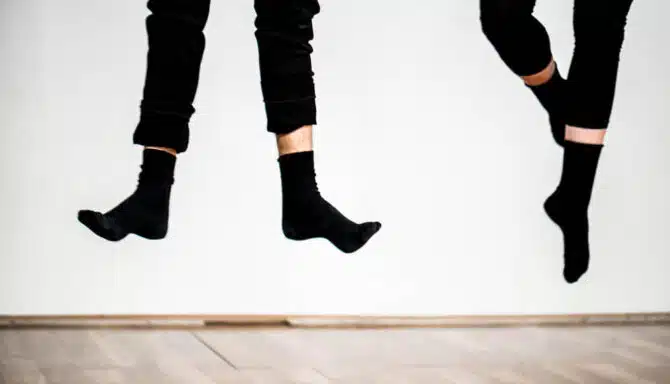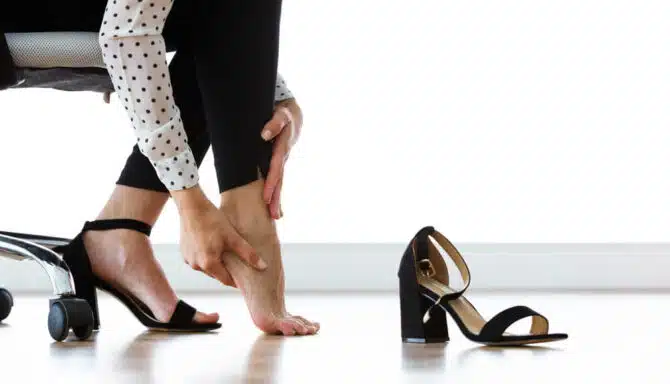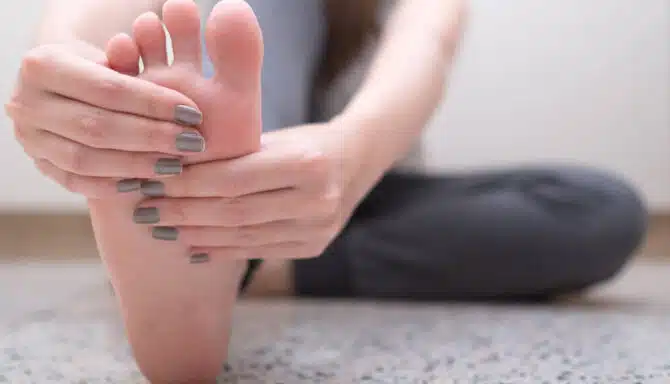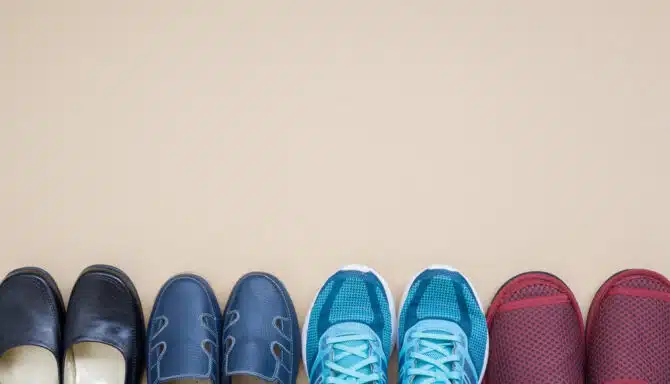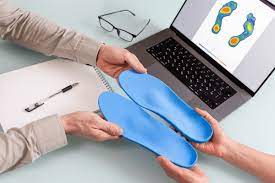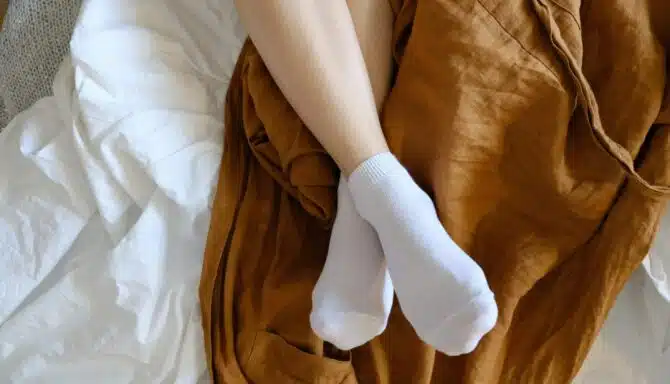February 27, 2025
Dealing with high arches and back pain can be a challenging combination, as the two are more connected than they seem. Understanding how high arches contribute to back pain is key to finding effective treatments and preventing further issues. Whether you’re dealing with foot pain, back pain, or posture problems, addressing high arches can significantly improve overall comfort and protect the rest of your body—especially your back.
What are High Arches?
https://www.youtube.com/shorts/osC-UmBtgNk
High arches (or cavus foot or pes cavus) is a condition where the foot has an abnormally pronounced arch (as opposed to a flat foot or a normal arch).
Having high arches can be due to simple genetics, inheriting structural abnormalities in the foot from your parents. They can also be caused by several neuromuscular disorders, which are conditions (ranging from mild to severe) that cause dysfunction or muscle weakness and leave certain muscles inactive.
High arches generally develop during or after childhood when the flat feet most children have start to take shape and the foot arch forms. In some cases, idiopathic pes cavus occurs without a known cause (like genetics or neuromuscular disorders), and is just a case of simple variations in bone and ligament structure.
A pronounced foot arch is usually quite discrete, aesthetically, and isn’t a serious condition. However, high arches are a common cause of foot pain and discomfort. High arches put extra pressure on the heel and ball of the foot, affecting normal pressure distribution and making it harder to absorb shock properly. This can lead to heel pain (plantar fasciitis— which is also commonly linked to flat feet feet), arch pain, and more, as the muscles and ligaments supporting the foot work overtime to stabilize each step, leading to inflammation or strain.
High arches often cause the foot to roll outward, a motion known as supination. This can place extra stress on the ankles and knees, further disrupting alignment and increasing the risk of injuries like sprains and shin splints.
It’s important to schedule an assessment with a foot specialist, like a podiatrist or chiropodist, if having high arches affects your daily life.
The Connection Between High Arches and Back Pain
https://www.youtube.com/shorts/7m3SQ5dXaeg
A pronounced arch can also lead to back pain. But how do high arches affect the back when the two areas seem relatively far apart?
The answer lies in how the body stays balanced. Many foot problems, not just high arches, often cause back pain—along with knee, leg, and ankle discomfort—because the feet serve as the body's foundation (carrying your weight) and closest connection to the ground. When that foundation is misaligned and overworked, the entire body has to compensate, leading to strain in other areas. Simply put, everything is connected, and the feet play a crucial role in maintaining functionality throughout our body’s kinetic connection!
When it comes to the back, pain and poor posture often coexist. As we know, when the arches are too high, they can throw off the body's natural alignment, affecting the way you stand and walk. Uneven weight distribution forces the lower body to compensate, which can lead to foot pain and posture issues over time. The strain on the feet may cause the ankles to supinate, shifting stress to the knees and hips. This misalignment can travel up the spine, making it harder to maintain proper posture and increasing the risk of chronic discomfort.
Without proper shock absorption, the impact of each step travels up through the joints, leading to tension in the lower back and shoulders. Over time, these small imbalances can create lasting posture problems, making everyday movements more difficult.
Treating High Arches and High Arch-Related Back Pain
When you treat high arches, you’re also preventing any potential back pain that may occur further down the road. But if you already struggle with high-arch related back pain, you can still focus on treatment methods that simultaneously target both issues.
Video Gait Analysis
https://www.youtube.com/shorts/Rhuga6vLdc0
This is when a Chiropodist or Podiatrist assesses your walking patterns (also known as your gait) using video gait analysis equipment. It can give foot care professionals insight into the potential damage your high arches could cause, so they can recommend preventative treatments.
Custom Orthotics and Insoles
A Podiatrist or Chiropodist can prescribe custom orthotics that you can wear inside your shoes. They will provide much-needed arch support, distribute weight evenly, and reduce strain on the feet and spine. Another option is over-the-counter Superfeet insoles, with the Superfeet Green: All Purpose High Arch being a good choice to ask your foot specialist about.
Supportive Footwear
Look for shoes with good arch support, cushioning, and shock absorption to minimize impact on joints. People with high arches should wear shoes with flexible midsoles or rocker soles to improve movement and reduce strain. Cushioning running shoes with shock absorption help counteract supination, ensuring even pressure distribution and healthy biomechanics. Avoid high heels, rigid soles, and unsupportive flats, as they can increase discomfort.
Read more about the link between footwear and back pain.
Stretching and Strengthening Exercises
https://www.youtube.com/shorts/-EeyHTdkrEs
Targeting the feet, calves, and lower back can improve flexibility and stability, reducing pain. Some of the best include towel stretches (where you place a towel under your foot arch and pull towards you), seated toe pulls (pulling the top of your foot towards you - see above!), ankle circles and massage ball rolls (rolling your foot arch on a therapeutic massage ball). You can read more about them, including how to perform them, here. You can also try clamshells on an exercise mat with your ankles together (this will also help soothe hip pain. See below for a demonstration!
https://www.youtube.com/shorts/ZODK0Q4zOws
January 9, 2025
Living with high arches can be a challenge, but if you pay attention to your foot health, you can manage them effectively. Let’s explore what high arches are, their impact, and our top 4 tips for living with high arches.
What Are High Arches?
https://www.youtube.com/shorts/13rmyA18ZzY
High arches (pes cavus) is a condition where one has - you guessed it - abnormally high foot arches. They are essentially the opposite of flat feet, which are characterized by having a minimal or non-existent arch. High arches may be hereditary or caused by neurological disorders such as Charcot-Marie-Tooth disease.
From a biomechanical perspective, the raised arch reduces the surface area in contact with the ground, which can result in an uneven distribution of weight across the foot. High arches often place excessive pressure on the ball and heel of the foot, leading to discomfort, instability, potential injuries and chronic foot conditions. High arches also impairs shock absorption, which causes progressive wear-and-tear on the joints over time.
Side effects of high arches include foot pain, issues like calluses and hammertoes, and an increased risk of ankle sprains. Individuals can also develop conditions like plantar fasciitis (this can also frequently occur in people with flat feet), or Achilles tendonitis due to the strain placed on the muscles and ligaments. The lack of shock absorption can also reverberate up the body and lead to joint disorders like arthritis.
High arches are associated with supination, also called underpronation, a condition where the foot rolls outward during movement. This gait pattern places additional stress on the outer edges of the foot and ankle, leading to instability and overuse injuries. Consequently, individuals with high arches should pay close attention to their walking or running patterns to prevent long-term complications.
High arches can also lead to changes in posture and gait. This, combined with the lack of shock absorption, may result in secondary issues such as knee, hip, or back pain over time.
Tips for Living with High Arches
https://www.youtube.com/shorts/2et0ZUSx4OM
Living with high arches requires thoughtful adjustments to your daily routine and habits. Here are some ways to keep your feet comfortable and supported:
1. Choose the Right Footwear
Proper footwear is essential for managing high arches. Opt for shoes with ample shock absorption, arch support and cushioning. Shoes with flexible midsoles or rocker soles can also be very helpful: People with high arches tend to have rigidity in the toes and ankles due to joint wear-and-tear, which means the toes and ankles do not flex as much as it should during the gait cycle. A flexible midsole and rocker sole counteracts this and make movement easier. Likewise, people with high arches should avoid high heels, rigid soles, and unsupportive flats, which can exacerbate discomfort.
Due to supination, people should look for cushioning running shoes. These provide balanced cushioning and plenty of shock absorption and flexibility to support the foot’s natural motion and healthy biomechanics. This design helps distribute pressure evenly, enhances comfort, and reduces the risk of injury.
2. Wear Custom Orthotics
Custom orthotics are a valuable tool for redistributing pressure evenly across the foot. You can work with a specialist, like a podiatrist or chiropodist, at a foot clinic to create orthotics tailored to your specific needs.
Scientifically, custom orthotics help correct abnormal biomechanics, such as excessive supination, by stabilizing the foot and encouraging a more neutral gait. They can also provide added cushioning to reduce the impact of your stride on your joints. Over time, this can alleviate pain, reduce fatigue, and prevent the development of secondary issues in the knees, hips, or lower back.
3. Maintain a High Arch Foot Care Routine
Foot baths and massages can soothe foot pain, relax the muscles in your feet and boost blood circulation.
Soak your feet in warm water with Epsom salts, or foot bath products from reputable companies like Gehwol, to alleviate tension. Gehwol products, such as their Herbal Foot Bath, are available to buy at our Toronto foot clinic, Feet First Clinic!
Gently massage the arch, heel, and toes to improve circulation and relieve tightness. Read this article to learn how to give yourself a foot massage from home.
4. Try Stretching and Strengthening Exercises
Foot stretches and exercises play a crucial role in managing high arches by improving flexibility, reducing muscle tightness, and promoting better blood circulation in the feet. High arches can lead to stiffness and imbalances in the tendons and muscles, increasing the risk of discomfort and injury. Over time, these stretches can support better alignment and strengthen the foot's ability to handle daily stress, making them an essential part of high arch foot care.
Here are some simple routines you can try today!
Toe Flex and Raise: While standing, plant your toes and lift your heels off the ground. Hold for 15-30 seconds and repeat 5 times.
Seated Towel Stretch: Loop a towel around your foot and gently pull it toward you, holding for 15-30 seconds.
Pen Pick-ups: Stay seated. Then, lay three pens, or similarly shaped objects, in front of you–spaced apart evenly. Using your toes, pick up each pen and place it in a bowl.
Seated Toe Pulls: Sit on a chair and cross one ankle over the opposite knee. Grab the top of your foot and gently pull it toward your body until you feel a stretch on the top of your foot. Hold for 15-30 seconds and repeat 2-3 times per foot.
https://www.youtube.com/shorts/-EeyHTdkrEs
Additional High Arch Pain Relief Tips
More practical approaches for high arch pain relief include:
Ice Therapy: Apply an ice pack to sore areas for 15-20 minutes to reduce inflammation and soothe discomfort. If your feet are particularly painful, take this one step further by practicing the RICE method (Rest, Ice, Compression and Elevation).
Supportive Inserts: Use over-the-counter insoles with firm arch support. A good choice for high arches is the Superfeet Green or the Superfeet Run Cushion High Arch insoles. However, talk to a podiatrist or chiropodist about if you need more customized support from orthotics.
Medication: Nonsteroidal anti-inflammatory drugs (NSAIDs) may help manage pain.
Seek Professional Help: Visit a podiatrist or chiropodist for a biomechanical assessment to determine how prominent your high arches are, how they are affecting your body, and any contributing biomechanical factors. These foot specialists can also fit you for custom orthotics, provide shoe recommendations and curate a full treatment plan.
When to See a Specialist For High Arches
If high arches are causing persistent discomfort or limiting your mobility, it’s essential to seek professional advice. As we mentioned, visiting a foot clinic ensures access to personalized treatment plans. Consulting a foot specialist is especially important if you notice:
Increased frequency of ankle instability or sprains.
Development of deformities like hammertoes, claw toes, or bunions.
Chronic pain that makes simple activities like walking increasingly difficult.
A foot specialist can recommend the appropriate treatments, depending on the severity of your condition. They may also suggest physical therapy to improve balance, coordination, and overall foot function.
Regular check-ups and assessments with a podiatrist or chiropodist can prevent seemingly minor issues from becoming major concerns. Don’t hesitate to seek their expertise!
https://www.youtube.com/shorts/XZUfVhny5pY
October 31, 2024
Foot pain can disrupt your life and make even simple tasks challenging. Whether you’re dealing with soreness, aching arches, or general fatigue, there are several ways to prevent foot pain. So we asked the chiropodists at our Toronto foot clinic their top tips to prevent foot pain. These expert tips also work for a) preventing full-blown foot conditions that constantly flare up and affect your life; and b) preventing existing foot conditions from getting worse. From daily foot care to choosing the right footwear, these expert tips will help you maintain healthier, happier feet.
5 Expert Tips to Prevent Foot Pain
Maintain Daily Foot Care
Perform Light Foot Exercises and Stretches
Wear the Right Footwear
Consider Your Lifestyle
See a Foot Specialist
1. Maintain Daily Foot Care
Daily foot care plays a critical role in preventing various foot issues and ensuring long-term comfort. Begin with moisturizing your feet regularly. Dry skin on the feet can lead to cracks and calluses, which not only cause pain but can also become a breeding ground for infections. Apply a moisturizing cream or lotion designed specifically for foot care after showering, as this helps lock in moisture and keeps the skin supple. It's important to use a dedicated foot cream - not a body or facial moisturizer - as the skin on our feet is thicker and has unique needs due to the stress and weight of our movement.
To get double the results with one action, amp up your at-home foot care routine with a self-performed foot massage when you moisturize. Massaging the soles of your feet and gently stretching each toe helps to release tension and boost blood flow. The arch of the foot is often noted as the “sweet spot” during a foot massage since the arch muscles are some of the hardest working in the human body.
Massages can be especially beneficial if you spend long hours on your feet or wear tight shoes (but remember, you need to stop doing the latter!). If you find sore spots, spend a bit more time on those areas to ease discomfort and prevent future pain.
Additionally, a soothing foot bath can go a long way in alleviating stress and enhancing your foot health. Warm water (hot water can dry out your skin) with Epsom salts can help reduce inflammation and improve circulation in the feet. For an extra boost, consider adding essential oils like lavender or eucalyptus, which offer calming and antibacterial properties. However, the most bang-for-your-buck can be found in foot bath products come from companies like Gehwol. These contain both essential oils AND medicinal ingredients, and are available at our Toronto foot clinic.
2. Perform Light Foot Exercises and Stretches
https://www.youtube.com/shorts/AsuUXJYnUmQ
Foot exercises and stretches are incredibly beneficial for keeping your feet limber and reducing stiffness. Incorporating gentle stretches can also help prevent foot injuries and make you less susceptible to other biomechanical conditions. Foot exercises work by maintaining flexibility and strength in the intrinsic and extensor muscles, tendons, and ligaments.
Some foot exercises are self-explanatory and very straight-forward, like ankle circles and towel curls. Ankle circles are perfect for improving range of motion; simply rotate each ankle clockwise and counterclockwise. For towel curls, place a towel on the floor and use your toes to scrunch it toward you. This simple exercise works the muscles on the underside of your feet.
For more specific guidance, take a look at these targeted exercises for common foot conditions:
Best exercises for plantar fasciitis: These exercises focus on stretching the plantar fascia ligament, which often causes heel pain when inflamed.
Best exercises for arthritis part 1 and 2: Aimed at maintaining mobility in the joints, these exercises help reduce stiffness and improve range of motion for individuals with arthritis.
Best exercises for diabetes: Diabetic foot exercises promote circulation, which is crucial for managing foot health in individuals with diabetes, as they are more prone to infections and sores.
Best exercises for bunions: These exercises can help strengthen the muscles around the big toe, improving alignment and reducing pressure on the bunion.
Adding these exercises to your routine can be instrumental in alleviating foot pain and keeping you active. Regularly performing these stretches will not only reduce discomfort but also prevent potential injuries by keeping your feet strong and resilient.
3. Wear The Right Footwear
https://www.youtube.com/shorts/xl6cE3oxDuE
Many people think foot pain is a normal part of life, and that ill-fitting shoes will not cause harm in the long run. None of this is true! Wearing appropriate footwear is perhaps one of the simplest yet most effective ways to prevent foot pain. There are 4 things to consider when selecting the right shoes: support, fit, purpose, and condition.
Support
Your feet bear the weight of your entire body, so providing them with the right support is essential. Shoes with adequate shock absorption help cushion the impact from the pavement, hard floors and ground when you walk or run, which reduces stress on all parts of the foot. Arch support is equally important; It distributes pressure evenly across your feet, minimizing strain on specific areas.
Fit
Ill-fitting shoes are a major cause of foot pain and can lead to conditions such as bunions, plantar fasciitis, and even arthritis. When shoes don’t fit properly, they can restrict movement and force your feet into unnatural positions, creating pressure points and friction.
To see if your shoes fit properly:
Look for footwear that allows enough room for your toes to wiggle - ideally between ⅜” to ½” of space between the end of your longest toe and the front of the shoe.
If you're feeling your toes knocking against the front of your shoes, they're too small. Conversely, if you're feeling your shoe moving around and sliding as you walk, they're too big.
Loosen the laces if the shoes feel too tight. If that doesn't work, look for a wide-width shoe; do not go up in length to accommodate width (you'll just end up with a long narrow shoe).
Always check the toe room when you're standing - not sitting. Our feet splay when we stand, which affects how the shoe fits.
Activities
Selecting shoes tailored to your specific needs is key. For example, runners should look for high-quality athletic shoes while people who walk or stand for long periods may benefit from shoes that have a removable insole so they can wear custom orthotics at work. Whatever your lifestyle, investing in quality footwear is one of the best foot pain tips anyone can follow.
Wear-and-tear
Lastly, shoes aren’t meant to last forever, even the best ones. You may need to rotate them based on seasonality, or if you think your foot size may have changed. Either way, rotate your shoes regularly to avoid the wear-and-tear that causes discomfort over time.
4. Consider Your Lifestyle
https://www.youtube.com/shorts/Y9kriXz1dL4
Foot health tips only go so far if you don’t understand your lifestyle and its impact on your feet.
As previously mentioned, athletes need supportive athletic shoes. These shoes are designed for activities that involve running, jumping, or quick lateral movements. Without proper footwear, athletes risk overuse injuries like shin splints, Achilles tendonitis, plantar fasciitis or stress fractures, which can be both painful and debilitating.
Seniors or individuals with mobility concerns, on the other hand, may benefit from orthopaedic footwear. Orthopaedic shoes are designed to support the structure of the foot and can accommodate issues such as arthritis or diabetic neuropathy. These shoes often feature wider toe boxes, extra depth, extra cushioning, and removable insoles to ensure maximum comfort and stability. For seniors, having footwear that reduces the risk of falls is crucial in maintaining independence and mobility.
Professionals who spend long hours on their feet, such as nurses, restaurant workers, or flight attendants, may need compression stockings in addition to solid footwear. The opposite is also true: office workers or anyone who works in a sedentary position can also benefit from compression stockings. Compression stockings promote blood circulation, reducing the risk of swelling and fatigue. By combining supportive shoes with compression stockings, these folks can significantly reduce foot pain that comes from standing for hours on end.
By aligning your footwear choices with your daily activities, age or general lifestyle, you can not only prevent pain but also enhance your life experiences. If you find that a specific activity or aspect of your lifestyle is causing foot discomfort, consider getting a foot assessment with a chiropodist or podiatrist. At a foot assessment, you'll get expert advice to ensure you're taking the right steps to prevent foot pain. Which leads to our last tip to prevent foot pain:
5. See a Foot Specialist
The best way to prevent foot pain is to be proactive. Adding a foot specialist like a chiropodist or podiatrist to your health care team is one of the best ways to do that. A chiropodist can do the following:
Routine foot care: This includes medical pedicures, corns, calluses and routine nail care. All of this is done in a safe, sterilized environment so you don't need to worry about infection. A chiropodist will also trim your toenails so they don't become ingrown, and will notice any problems you may not. The best part about seeing a chiropodist for foot care is that they can give you expert advice for taking care of your feet at home.
Foot & Biomechanical Assessments: A chiropodist can do a biomechanical assessment and gait analysis to diagnose any potential foot concerns that can lead to pain. For instance, a chiropodist can see if you overpronate or have flat feet. You can then get expert advice to manage it so it doesn't cause problems down the road. A chiropodist can also recommend footwear based on your foot type and gait pattern, as well as any exercises, stretches or devices that can help prevent foot pain.
https://youtube.com/shorts/XZUfVhny5pY?si=VWt1aoyRtpAxQKFS
October 21, 2024
Selecting the best footwear for foot health is an often overlooked part of self care. The right shoes not only get your feet from point A to B, but can also prevent various types of foot pain, like arch pain or heel pain. Better yet, solid shoe choices can shield your feet from some of the most frustrating chronic foot conditions. In this guide, we’ll walk you through the key features to look for in supportive shoes and why these elements matter for healthy feet.
Arch Support
Arch support is key for foot pain prevention and daily comfort. This feature helps position the foot in a healthy arch alignment so it can support your body weight more evenly. Studies show this is extra helpful for people with flat feet and high arches— essentially creating the normal arch they need. Lack of proper arch support can lead to conditions like plantar fasciitis. Arch support in shoes typically looks like a raised, curved section along the inner part of the insole.
Here is an example with one of our customers who has flat feet:
https://youtube.com/shorts/xl6cE3oxDuE?si=5D-XBSf2NlYVWlFr
Shock Absorption
Shock absorption is a must-have for athletes, long walk lovers, or those who work on their feet, like servers or construction workers.
https://youtube.com/shorts/_Wz9V_ND7Og?si=qO1aBE5RjK1jU9FD
It's essentially cushioning that keeps the harsh effects of the pavement, floor, trails and more from damaging your joints. This is especially important for people with conditions like arthritis or heel spurs. Supportive shoes with adequate shock absorption use materials like EVA foam or cork to cushion the foot or to redistribute pressure, thereby minimizing strain on the feet, ankles, knees, and lower back. Click here to learn more about it!
Grip
Is fall prevention important to you? If yes, make sure you buy non-slip shoes or shoes with a solid-grip outsole.
A firm grip is vital for healthy feet because it reduces the risk of sprains or fractures. It should work on various surfaces, from slick sidewalks to gravel paths. Older people with balance issues should ensure their shoes have this crucial feature.
https://youtube.com/shorts/AfuPpZv2LP4?si=371c43MRLBoloMGQ
Waterproofing and Breathable Materials
Waterproof shoes (such as shoes made with GORE-TEX fabric) keep your feet dry in wet conditions, reducing the risk of fungal infections and blisters. Likewise, breathable fabrics with perforation in the shoe’s upper promotes air circulation, which is a top-priority feature for many athletes at the gym. That said, choosing the right materials can make a significant difference in comfort and hygiene for everyone, not just athletes.
Removable Footbeds
It may seem counterintuitive to buy a shoe that has something you don’t need, but hear us out! The best footwear for foot health typically have them!
Shoes with removable footbeds offer customization options for those who need orthotics or insoles from brands like Superfeet. From pregnancy to diabetes, many conditions require this shoe perk.
This feature may also make it easier to keep your shoes clean, or even extend their lifespan since you aren’t using its original footbed as often.
https://youtube.com/shorts/KZiVzLyBUMo?si=krALP19KEv0r6SmU
September 26, 2024
Orthotics are supportive, custom devices designed to improve the alignment and function of the feet, ankles, and lower limbs. They aim to address specific issues like flat feet, overpronation, or arch support. This can help alleviate discomfort and prevent injuries by redistributing pressure and correcting abnormal movement patterns. Adequately fitted orthotics can significantly enhance comfort and mobility, making daily activities more manageable and pain-free.
Custom orthotics can make a big difference, but how exactly do orthotics correct foot alignment? And how do they work? Let's explain.
What are orthotics?
Orthotics are specialized, custom-designed insoles that you place inside your shoes. They come in many forms, and are molded and constructed specific to your unique foot needs. Their main job is to support and correct the alignment of your feet, which can help address various foot and lower limb issues. They essentially promote healthy biomechanics to ensure your body moves the way it's designed to.
Orthotics are custom-made specifically for your feet by a chiropodist (foot specialist). The chiropodist will do a biomechanical and gait analysis, and then take a mold of your foot (typically with a 3D digital scanner). The chiropodist then custom-designs the orthotics according to your specific needs, and a lab then constructs the orthotics according to the chiropodist's instructions.
https://youtube.com/shorts/pO5oWb6S5MA?si=LKskZKFzoAaIxV6h
It's important to note that while orthotics can be beneficial, they may not be suitable for everyone and can have some drawbacks, such as initial discomfort and the need for regular maintenance. Custom orthotics are more expensive than over-the-counter options, but they are an investment in your future — they may allow you to avoid more severe issues and chronic pain long-term, and can address foot concerns that over-the-counter insoles cannot. Not to mention, they are longer-lasting.
How orthotics correct foot alignment?
Orthotics are meant to modify how your foot moves and distributes pressure. They can help with several conditions, including:
Flat feet: Orthotics can support fallen arches to maintain and prop up the natural contours of your foot.
High arches: When you have high arches, excessive pressure is placed over a very small area of your foot. Orthotics help by cushioning and distributing pressure more evenly. If pressure is unevenly distributed across your feet, you're at a higher risk of overworking neighbouring parts of your foot.
Overpronation: If your feet roll inward too much when you walk or run (called "overpronation), orthotics can help correct this movement. They do this by creating a barrier to your foot's inward movement, which corrects the overpronation. (Interesting fact: people with flat feet are prone to overpronation, so the treatment for the two conditions is often the same).
Heel pain: Orthotics can reduce the strain on the plantar fascia and help alleviate heel pain.
By correcting foot alignment, orthotics can provide significant relief from pain and prevent future issues. The feet are our body's foundation, so when your feet are moving properly, it helps the rest of our body move properly. That allows muscles and joints to work the way they were designed to without being over-stressed. This then helps reduce pain - not only in our feet, but the rest of our body too!
Types of orthotics
There are many different types of orthotics designed for different footwear and activities. Click here to learn more!
https://youtube.com/shorts/IBXAXoUouFY?si=u9Uv6wcGhSEheI1t
Benefits beyond pain relief
Orthotics don't just help with pain—they can also play a proactive role in enhancing overall foot and body health. Proper alignment can lead to better posture, reduced knee and hip stress, and improved gait. Athletes often use orthotics to boost performance by optimizing foot mechanics, which then reduces the strain on the rest of their joints.
How to choose the right orthotics
If you're considering orthotics, here's what to keep in mind:
Consult a professional: A chiropodist can help determine if you need custom orthotics through a biomechanical assessment. They can then prescribe, design and fit your orthotics based on your activities and specific foot concerns. A chiropodist may also recommend footwear and over-the-insole options to test out first before going the custom route.
Consider your activities: Choose orthotics that match your lifestyle. For instance, if you're a runner, look for ones designed to absorb shock and provide stability. If you work in a setting with a formal dress code, you may want to opt for slimmer dress orthotics that will fit into your dress shoes.
Look at the full picture: Orthotics alone likely won't solve all your foot concerns. They're just part of the equation. You'll also want to ensure your wearing proper footwear and maintaining an active, healthy lifestyle. If you have chronic pain or a conditions like arthritis, regular exercise and stretching is very important to build strength in your feet and ankles. Orthotics are essentially meant to supplement a healthy lifestyle - not substitute it.
How to get the most out of your orthotics
Once you have your orthotics, wear them regularly to see the best results. They take some time to get used to, so gradually increase the time you wear them daily. Also, remember that orthotics are just one part of foot health—maintaining a proper exercise routine and suitable footwear are equally important. To ensure the longevity of your orthotics, clean them regularly and follow any specific care instructions provided by the manufacturer or your chiropodist.
September 12, 2024
Looking to end your stint with foot arch pain? You've come to the right place. This post explores different kinds of arch pain, what causes it, and our top tips for foot arch pain relief.
Plantar fasciitis
Plantar fasciitis occurs when the plantar fascia (the thick band of tissue running along the bottom of your foot) becomes inflamed. It typically causes sharp pain in the heel and arch, especially in the morning or after periods of rest.
Cause: Repeated stress on the feet, especially from high-impact activities, can strain the arch and lead to pain. Increased body weight can also stress the feet more, leading to arch pain and discomfort. Finally, shoes lacking adequate arch support or cushioning and poorly fitted shoes can exacerbate foot pain.
How to alleviate pain: Rest, recovery and ice are the first things you should do to alleviate plantar fasciitis. The next step is to invest in footwear with proper arch support and cushioning. You can also upgrade your existing footwear with insoles or orthotic inserts designed for arch support. Custom orthotics help redistribute pressure in your foot and reduce strain on the arch. Stretching exercises for the Achilles tendon and plantar fascia can also reduce inflammation and arch pain associated with plantar fasciitis..
https://youtube.com/shorts/rSKd2ztKWa8?si=LasK80y8b4hN0VQH
High arches
People with high arches often experience discomfort in the arch and heel due to insufficient shock absorption. This condition can lead to an imbalance in foot mechanics, causing pain in various parts of the foot.
Cause: Genetic factors can play a role in high arches.
How to alleviate pain: Cushioned, supportive shoes and insoles can help manage arch pain associated with high arches. Look for footwear with ample cushioning and arch support to alleviate discomfort. Specific high arch exercises can also help.
https://youtube.com/shorts/-EeyHTdkrEs?si=9cEtqdFuRFNPN33M
Flat feet
Also known as fallen arches, flat feet affects the arch's ability to properly support a person's body weight, which then leads to arch pain. Flat feet can cause many biomechanical issues, which can lead to overpronation (where the foot rolls inward excessively), plantar fasciitis, and many other foot conditions, all of which contribute to foot and ankle pain.
Cause: Like high arches, genetic factors can play a role in flat feet. Flat feet can predispose individuals to certain types of foot pain.
How to alleviate pain: Proper arch support is key for foot arch pain relief. People with flat feet should look for stability shoes. These shoes are specially designed to correct overpronation and properly support the arch. Custom orthotics can also significantly support fallen arches. They're tailored to your foot's needs and help improve alignment and pain. You can get custom orthotics at our foot clinic by booking an Orthotic Assessment appointment with one of our licensed chiropodists.
https://youtube.com/shorts/whJ3TZAOn00?si=_Ln3722OlmIV7wRS
